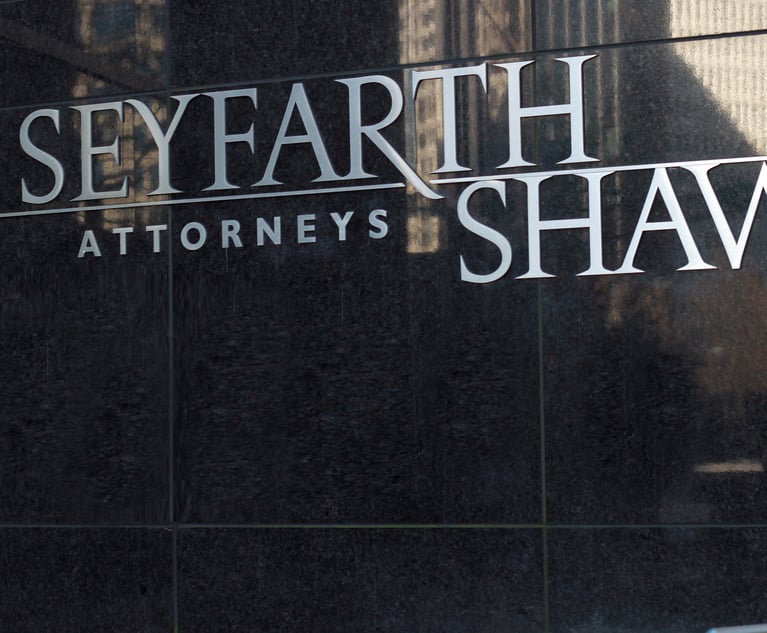 Photo: Shutterstock
Photo: ShutterstockAs Remote Work Brings Isolation, How Can Firms Keep Lawyers in the Fold?
"The kind of interpersonal communication that people have on a coffee break or in the lunchroom is now gone," said one behavioral scientist who's also a Big Law alum. "Firms are going to have to work to keep their people committed and engaged."
March 31, 2020 at 04:48 PM
4 minute read
The original version of this story was published on The American Lawyer
As law firms settle into working remotely, keeping connected is turning out to be much more than just a technical challenge. And while many firms are finding ways to encourage communication and check in with employees during the COVID-19 pandemic, those contacts haven't extended to everyone.
A survey released this week by Chicago-based consulting firm The Red Bee Group found that the vast majority of lawyers and staff respondents—90%—were somewhat or very satisfied with the systems in pace for remote working at their firms or legal organizations. But significant percentages had not been included in group meetings designed to maintain contacts or had not had their supervisors personally check in.
More than a quarter—26%—said they had not participated in an employer-led conference call or video meeting designed to stay in touch with colleagues. One-on-one outreach by supervisors to see how personnel were coping was also uneven, with 60% reporting email contacts, 52% saying they had received a check-in phone call, 35% reporting contact through text message and 29% connecting via video chat.
"That was one of the most striking themes that came out of this research," said Stephanie Scharf, a principal at Red Bee, a behavioral scientist and a former partner at Kirkland & Ellis and Jenner & Block who now has her own firm. "The kind of interpersonal communication that people have on a coffee break or in the lunchroom is now gone. Firms are going to have to work to keep their people committed and engaged."
Roberta Liebenberg, a principal at Red Bee and a senior partner at Fine, Kaplan and Black in Philadelphia, echoed that reaction. "Law firms are going to need to communicate in a way they are not really used to," she said. "They need to communicate with empathy and get personal with their lawyers."
The survey, conducted by email and through social media platforms such as LinkedIn, included responses from over 300 individuals in 34 states and Washington, D.C. About three quarters worked at law firms, but in-house, nonprofit and government employees were also represented.
The responses were gathered March 23 and 24, and 96% of respondents said they were working remotely by that time, with more than 50% saying their employers sent workers home before government mandates left then with no choice.
Since then, firms have experimented with different ways to maintain a sense of community and shared mission among their suddenly dispersed workforces. Joshua Jarvis, a Boston-based partner and the intellectual department co-chair at Foley Hoag, said on top of individual calls to staff, his department has started producing two weekly newsletters.
The first, released Mondays, covers work-related matters such as new business, speaking engagement announcements and firm news.
The second, released Wednesdays, is more of a "lifestyle" publication, he said.
"It's what the staff is doing at home," Jarvis said. "Photos of kids, pets and workspaces. It's been fun for people to share what they are doing. The goal is to keep people connected. Every time we send one, we get a couple of personal notes thanking us for emphasizing that we are not 150 disconnected people. We are a department that is working together."
And that work has not dried up for many, according to the Red Bee survey, with nearly half of respondents reporting that they were at least as busy as before. Still, nearly as many—42%—said they had experienced a reduction in their volume of work compared to normal times.
Nevertheless, 90% of respondents said their firms or companies have not reduced billable hours requirements or working hours.
Respondents were satisfied overall with their employers' dissemination if health related information during the COVID-19 crisis, such as clarity on sick leave matters, with 72% saying they had received employer guidance.
There were some gaps, though, as only 41% said they had received information on maintaining mental health from home, and only 21% said they had received any information regarding maintaining child care efforts while working remotely.
The researchers concluded that employers will need to find ways to communicate more, and more consistently, in order to counter the disruptions of the COVID-19 crisis. They analysts also suggested that employers consider adjustments to workloads, although that would be dependent upon the particular firm or practice being impacted.
"There is no such thing as too much communication with your attorneys," Scharff said.
|Read More
For Some Law Firm Support Staff, Pandemic Brings New Uncertainty
This content has been archived. It is available through our partners, LexisNexis® and Bloomberg Law.
To view this content, please continue to their sites.
Not a Lexis Subscriber?
Subscribe Now
Not a Bloomberg Law Subscriber?
Subscribe Now
NOT FOR REPRINT
© 2025 ALM Global, LLC, All Rights Reserved. Request academic re-use from www.copyright.com. All other uses, submit a request to [email protected]. For more information visit Asset & Logo Licensing.
You Might Like
View All
New Year, New Am Law 100: Challenges Await These Newly Merged Law Firms
7 minute read

Why Hogan Lovells and Perkins Coie Reversed, Will Now Pay Out Special Bonuses to Associates
4 minute readLaw Firms Mentioned
Trending Stories
- 1Letter From London: 5 Predictions for Big Law in 2025, Plus 5 More Risky Ones
- 2Crypto Groups Sue IRS Over Decentralized Finance Reporting Rule
- 3Jenner Brings Back Zachary Schauf from DOJ's Office of Legal Counsel
- 4'Erroneous Assumption'?: Apple Challenges DOJ Antitrust Remedy in Google Search Monopoly Case
- 5A Jury to Determine Whether Stairs Were Defectively Designed in Injury Case, State Appellate Court Rules
Who Got The Work
Michael G. Bongiorno, Andrew Scott Dulberg and Elizabeth E. Driscoll from Wilmer Cutler Pickering Hale and Dorr have stepped in to represent Symbotic Inc., an A.I.-enabled technology platform that focuses on increasing supply chain efficiency, and other defendants in a pending shareholder derivative lawsuit. The case, filed Oct. 2 in Massachusetts District Court by the Brown Law Firm on behalf of Stephen Austen, accuses certain officers and directors of misleading investors in regard to Symbotic's potential for margin growth by failing to disclose that the company was not equipped to timely deploy its systems or manage expenses through project delays. The case, assigned to U.S. District Judge Nathaniel M. Gorton, is 1:24-cv-12522, Austen v. Cohen et al.
Who Got The Work
Edmund Polubinski and Marie Killmond of Davis Polk & Wardwell have entered appearances for data platform software development company MongoDB and other defendants in a pending shareholder derivative lawsuit. The action, filed Oct. 7 in New York Southern District Court by the Brown Law Firm, accuses the company's directors and/or officers of falsely expressing confidence in the company’s restructuring of its sales incentive plan and downplaying the severity of decreases in its upfront commitments. The case is 1:24-cv-07594, Roy v. Ittycheria et al.
Who Got The Work
Amy O. Bruchs and Kurt F. Ellison of Michael Best & Friedrich have entered appearances for Epic Systems Corp. in a pending employment discrimination lawsuit. The suit was filed Sept. 7 in Wisconsin Western District Court by Levine Eisberner LLC and Siri & Glimstad on behalf of a project manager who claims that he was wrongfully terminated after applying for a religious exemption to the defendant's COVID-19 vaccine mandate. The case, assigned to U.S. Magistrate Judge Anita Marie Boor, is 3:24-cv-00630, Secker, Nathan v. Epic Systems Corporation.
Who Got The Work
David X. Sullivan, Thomas J. Finn and Gregory A. Hall from McCarter & English have entered appearances for Sunrun Installation Services in a pending civil rights lawsuit. The complaint was filed Sept. 4 in Connecticut District Court by attorney Robert M. Berke on behalf of former employee George Edward Steins, who was arrested and charged with employing an unregistered home improvement salesperson. The complaint alleges that had Sunrun informed the Connecticut Department of Consumer Protection that the plaintiff's employment had ended in 2017 and that he no longer held Sunrun's home improvement contractor license, he would not have been hit with charges, which were dismissed in May 2024. The case, assigned to U.S. District Judge Jeffrey A. Meyer, is 3:24-cv-01423, Steins v. Sunrun, Inc. et al.
Who Got The Work
Greenberg Traurig shareholder Joshua L. Raskin has entered an appearance for boohoo.com UK Ltd. in a pending patent infringement lawsuit. The suit, filed Sept. 3 in Texas Eastern District Court by Rozier Hardt McDonough on behalf of Alto Dynamics, asserts five patents related to an online shopping platform. The case, assigned to U.S. District Judge Rodney Gilstrap, is 2:24-cv-00719, Alto Dynamics, LLC v. boohoo.com UK Limited.
Featured Firms
Law Offices of Gary Martin Hays & Associates, P.C.
(470) 294-1674
Law Offices of Mark E. Salomone
(857) 444-6468
Smith & Hassler
(713) 739-1250







